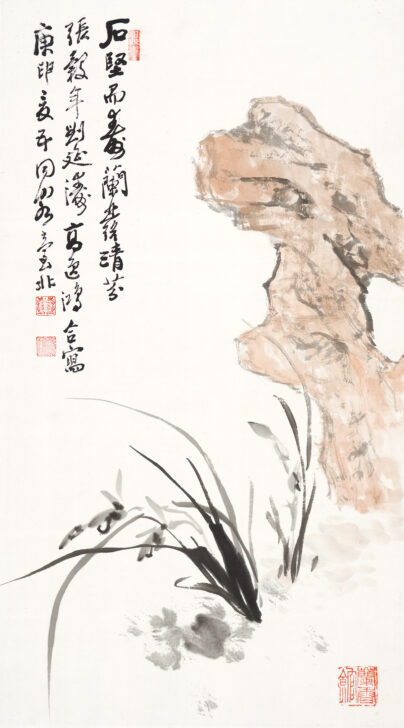Orchids and Red Rock
Chang Ku-nien, Liu Yantao, Gao Yihong

Description
Literati theory considered paintings modes of personal expression, to be created for private occasions and shared and appreciated within circles of friends. The creation of works with peer artists was also a literati concept and practice. These two paintings are cooperative works by Chang and his wife (Plum Blossoms in Snow) and by Chang and his artist friends (Orchids and Red Rock). Cooperative work celebrated respectful mutual relationships and reinforced affections within groups of painters. Inscriptions on such works often declare their corporate nature, mentioning all of the artists’ names and specifying who has done what part. It is common for each artist to be responsible for the part of the painting that best reveals his or her talents. In Plum Blossoms in Snow, the inscription by Chang’s wife reports that she painted the blossoming plum and snowy bamboos and her husband the rest. A plum tree blossoming in snow symbolizes both purity and durability, since tender plum buds courageously bloom even while early spring snow is still on the ground.
Who painted what is not clearly indicated in Orchids and Red Rock, but Chang most likely painted the rock and Liu Yantao and Gao Yihong were responsible respectively for the inscription and orchids. Orchids were a subject appealing to scholar-artists, and their elegance and subtle fragrance have long been regarded as the emblem of righteous gentlemen.
(Tradition Transformed: Chang Ku-nien, Master Painter of the 20th Century, Winter 2010)
Gallery Rotation Spring/Summer 2012
Orchids and Red Rock
1980
Hanging scroll, ink, and light color on paper
Gift of Dr. Cheng-Yang and Mrs. Shirley Chang, 2006/1.132
Literati theory considered painting to be a mode of personal expression; often works were created for private occasions at which they were shared with and appreciated by circles of friends. The creation of works with artist-peers was also an established literati practice and often celebrated respectful mutual relationships, reinforcing affections within groups of painters. This is a cooperative work by Chang Ku-nien and some artist friends. Inscriptions on such works often declare their communal nature, mentioning all of the artists’ names and specifying who has done what part. It is common for each artist to be responsible for the part of the painting that best reveals his or her talents. Yet who painted what is not clearly indicated in this work; most likely Chang Ku-nien painted the rock while Liu Yantao and Gao Yihong were responsible, respectively, for the inscription and orchids. Orchids were appealing subjects to scholar-artists, and their elegance and subtle fragrance have long been regarded as the emblem of righteous gentlemen.
Subject Matter:
Literati theory considered paintings modes of personal expression to be created for private occasions in which they were shared and appreciated by circles of friends. The creation of works with peer artists was also an established literati concept and practice. This painting is a cooperative work by Chang Ku-nien and his artist friends. Cooperative work celebrated respectful mutual relationships and reinforced affections within groups of painters. Inscriptions on such works often declare their corporate nature, mentioning all of the artists’ names and specifying who has done what part. It is common for each artist to be responsible for the part of the painting that best reveals his or her talents. Yet who painted what is not clearly indicated in this work; most likely Chang Ku-nien painted the rock while Liu Yantao and Gao Yihong were responsible respectively for the inscription and orchids. Orchids were appealing subjects to scholar-artists, and their elegance and subtle fragrance have long been regarded as the emblem of righteous gentlemen.
In Orchids and Red Rock, although it was not clearly indicated who did what, Chang most likely painted the rock and his two friends from the Seven Friends Painting Club that he participated, Liu Yantao and Gao Yihong, were responsible for the inscription and orchids respectively. Naturally, in a cooperative work, each artist often takes on a subject best representing his/her talents. Appealing to scholar-artist, the elegance and subtle fragrance of orchids have long been regarded as the emblem of righteous gentlemen, thus a suitable subject for scholars alike.
Physical Description:
A rough, red rock seems to grow out of the hillside, almost as organically as the orchids growing next to it. Calligraphic text is in the upper left corner.
Usage Rights:
If you are interested in using an image for a publication, please visit https://umma.umich.edu/request-image/ for more information and to fill out the online Image Rights and Reproductions Request Form.